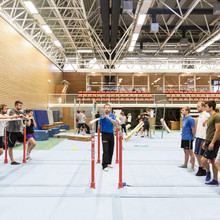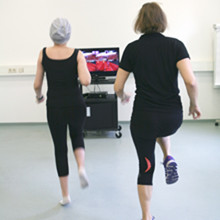Research Areas

Department I - Movement technique and Motor learning - Athletics, Swimming and Gymnastics
[The employees of the department I are involved in the parent-fields of action competitive sport, recreational sport and school sport. In these fields, the elementary motor movement forms are examined, which can be realized within the framework of movement techniques in the primary areas of application (gymnastics, athletics, swimming and related individual sports).
The focus is on the main motor forms of demand coordination, strength, endurance and flexibility, which are not isolated but considered within the sport-specific movement technique. Technology analysis becomes an important position in the examination. The technology analysis goes beyond an exclusive description of motor solutions for motion and is primarily concerned with the identification of the motor performance determining movement technical factors.
Closely linked to a so-understood technology analysis are in particular issues of coordination and linking of muscular drives, whose temporal processes also energy conversion and neuronal generation of motion programs, their optimization and modification, their stability as well as depending on the age and health status. A special requirement depicts the practical teaching material and didactic implementation of the findings.

Department II - Movement Neurosciences
Focal point of the department is to research the influence of different physical burdens (especially the main motor forms coordination, strength, and endurance in their diverse differentiations) on the brain. A key research project is the analysis of the brain in motor activity of neuronal and endocrine systems, as well as the detection of cerebral blood flow and brain metabolism in cognitive and physical stresses of trained and untrained persons of different ages.
The findings will be discussed in terms of their releveance to health status, central fatigue, overtraining and mood. The focus of research interest is the importance of the neurotransmitters serotonin and dopamine for physical and cognitive performance, as well as adaptations of these neurotransmitter systems while training of different intensities.
The influence of specific environmental conditions, e.g. weightlessness on motor performance and learning ability is also being investigated, taking into account the interaction of physiological, endocrinological and psychological findings. Together with the Institute of Biomechanics and Orthopaedics and the Institute for Cardiovascular Research and Sports Medicine, the "Research Center for Neuroplasticity and Neuromechanic" is currently being established. This represents another important step for the University on the innovative research field of movement neuroscience. In the field of sport for people with disabilities, the preventive-therapeutical orientation is more often accompanied with the competition and performance concept recently. In this area, the Institute is engaged in evaluating the performance, especially in wheelchair sports, with the aim of optimizing training control.

Department III - Department for physical activity in public health
In 2008, the research field of exercise and health promotion was developed at the Institute. Today's living conditions in children and adolescents, but also adults, lead to overweight problems and a reduction in physical fitness. This entails consequent diesases and sicknesses as diabetes mellitus, hypertension etc.
These developments lead to new scientific and applicationary demands for discorveries. In the center of the department are the scientific treatments of possible connections and the effectiveness and sustainablity countermeasurements (www.chilt.de). In addition to the conception of motor testing procedures for children and adolescents (www.fitnessolympiade.de), realistic oriented programs are developed and tested. In cooperation with the Cologne Centre for Prevention in Childhood and Adolescence, the benefits of exercise during pregnancy will be examined in terms of prenatal imprinting to derive recommendations for practice from these findings.
Department IV - Movement Rehabilitation, Neuromechanics and Paralympics Sports
The staff* of Department IV are concerned with specific aspects of movement science from rehabilitation to top-level-sport especially in Paralympic sports.
In movement-rehabilitation the main focus is on the development of intelligent technologies which in the sense of optimising rehabilitation processes are intended to ensure that people can become independent in everyday life and can participate as fully as possible in all areas of life.
In this context movement neuro mechanics represents an interdisciplinary approach to movement research. It combines methods and findings from neuroscience and the mechanics of the musculoskeletal system. The focus is on the complexity and dynamics of the entire system consisting of the central planning and development of movement neural control and the involvement of mechanical components of the musculoskeletal system. The knowledge generated on the movement of the human body is used for analysis and functional enhancement in popular sports, preventive and rehabilitative sports as well as in Paralympics and Olympic top-class sports.

